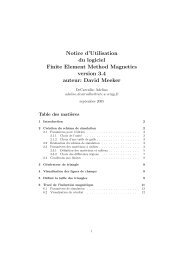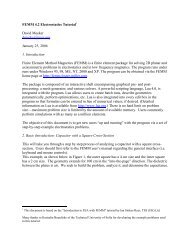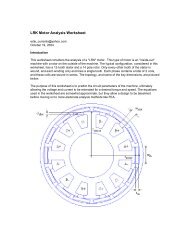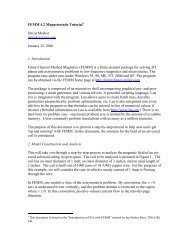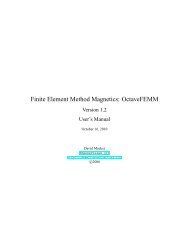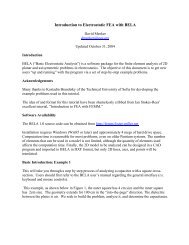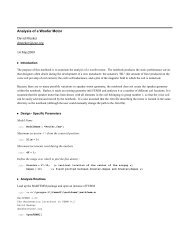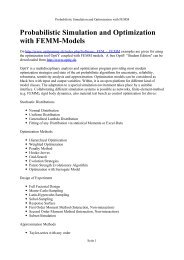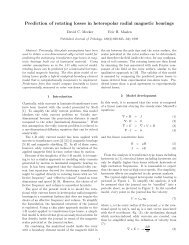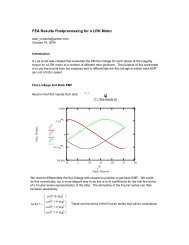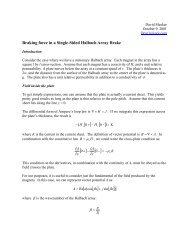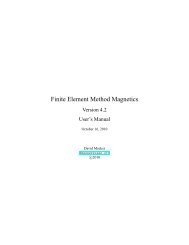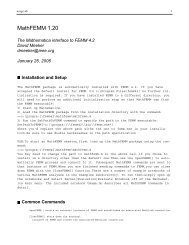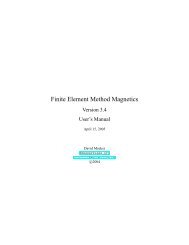FEMM Manual - Finite Element Method Magnetics
FEMM Manual - Finite Element Method Magnetics
FEMM Manual - Finite Element Method Magnetics
You also want an ePaper? Increase the reach of your titles
YUMPU automatically turns print PDFs into web optimized ePapers that Google loves.
where the first bracketed term in (2.10) is the contribution from the turns of coil 2 that are<br />
pointed out of the page and the second term is the contribution from the turns of coil 2 that<br />
are pointed into the page. To evaluate mutual inductance with <strong>FEMM</strong>, one substitutes values<br />
into (2.10). First, run the model with only “coil 1” turned on. Then, integrate A over the<br />
volume in which the second coil lies (although the second coil is not turned on). For planar<br />
problems, you will typically have to make two separate integrations–one over the region<br />
where the turns in “coil 2” are pointed out of the page (i.e. that part of the coil in which<br />
a positive current results in current flowing in the out-of-the-page direction), and one over<br />
the region in which the turns in “coil 2” are pointed into the page. Add these two results<br />
together to get the total A1dV2 integral. Lastly, multiply the integral result times n2/(i1a2) to<br />
get mutual inductance.<br />
• Magnetic field energy This selection calculates the energy stored in the magnetic field<br />
in the specified region. This integral can be used as an alternate method of getting inductance<br />
for problems that are linear (at least not heavily saturated). Denoting E as the energy stored<br />
in the magnetic field, inductance can be obtained by solving the formula:<br />
E = Li2<br />
2<br />
(2.11)<br />
In the case of nonlinear materials, the energy is computed via:<br />
Z �Z B<br />
W = H(B ′ )dB ′<br />
�<br />
dV (2.12)<br />
to take proper account of the energy under nonlinear conditions<br />
0<br />
• Magnetic field coenergy For linear problems, coenergy is numerically the same as energy.<br />
For nonlinear problems, coenergy is defined as:<br />
Z �Z H<br />
Wc = B(H ′ )dH ′<br />
�<br />
dV (2.13)<br />
0<br />
Coenergy can be used in an alternative method of force and torque computation. To compute<br />
force via coenergy, currents are held constant, and the position of the object upon which the<br />
force is desired is perturbed slightly. The force can then be estimated by:<br />
F = Wc(p+δ) −Wc(p)<br />
δ<br />
(2.14)<br />
where p denotes the initial position, p+δ denotes the perturbed position, and δ is the magnitude<br />
of the perturbation. The component of force determined in this way acts along the<br />
direction of the perturbation–one has to perform two such operations to get both horizontal<br />
and vertical components of the force.<br />
• Hyst. and/or Laminated eddy current losses. This selection is typically used to<br />
obtain the core losses produced in laminated iron sections in harmonic problems.<br />
• Resistive losses This selection integrates the i 2 R losses due to currents flowing in the<br />
“z” direction (or θ direction, if you are evaluating an axisymmetric problem).<br />
42



